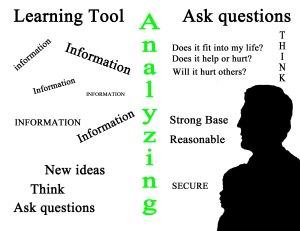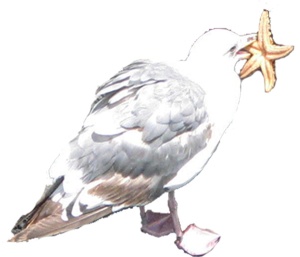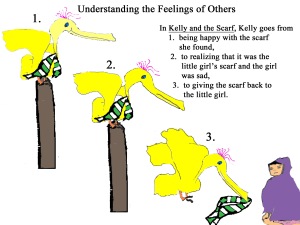
Each new day comes
With its prizes unassembled.
Be handy with your tools.
Author Unknown
INFORMATION. INFORMATION. INFORMATION.
TV! Radio! Internet! Signs! Talk!
Everywhere people are telling us something!
Tools For Learning
Our brains are gathering a tremendous amount of information. Does it help us live better? Or does it mess up our lives? How does a child make sense of all this to learn and grow into a healthy, confident person?
There are some things we as adults can do.
We must be our children’s secure, solid base. I started to use the word “stable.” Then I looked it up to see if there was a better word to convey my meaning and found so many wonderful synonyms for what parents and adults caring for children should be for them: secure, solid, strong, steady, firm, steadfast, reasonable, sensible. Notice I said “should.” We all know that there are lots of times we fall short of the ideal. But, we keep trying.
Analyzing As A Skill
When children are very young we can filter and monitor some of the media and information they can get. We can let their young lives be filled with playing, and doing things, and helping, and listening to books, and music, and being outside in nature, and learning to interact with us and others. And while they are young we can help them learn to think about what they see and hear, organize it in their brains, and figure out if it fits into their life to help them or not. Here are some ideas of how to help them do it.
- TALK to your children and LISTEN to them. Be their go-to person to ask questions. Children have lots of questions. Encourage them to ask, then help them find answers and learn how to find other resources for answers.
- ASK CHILDREN QUESTIONS. This helps them think about the information and find out what they want to learn more about. When you read with children, ask them questions about what you are reading. “What would you do if you were the main character in t
 he book?” “If you could talk to the main character, what would you want to ask?” “How do you think a character felt when something happened?” “What does this story make you want to know more about?” One of our reasons for putting an alphabet of things that sea and ocean animals eat at the back of our book Delly and The Beach Town Healthy Alphabet Challenge was to get children to think about other forms of life and other types of food and to begin to appreciate the great variation of life in this world. Don’t overdo the questioning, put the emphasis on the child being involved.
he book?” “If you could talk to the main character, what would you want to ask?” “How do you think a character felt when something happened?” “What does this story make you want to know more about?” One of our reasons for putting an alphabet of things that sea and ocean animals eat at the back of our book Delly and The Beach Town Healthy Alphabet Challenge was to get children to think about other forms of life and other types of food and to begin to appreciate the great variation of life in this world. Don’t overdo the questioning, put the emphasis on the child being involved.
- ENCOURAGE CHILDREN TO THINK ABOUT HOW OTHERS FEEL. Helping them see things from another perspective will serve them well as they grow and make our world a better place. In our book, Kelly and the Scarf, Kelly, who likes colorful things, sees a scarf, picks it up and takes it for herself. However, when she sees the little girl who lost the scarf, and understands how the girl feels, Kelly returns it to the girl. Be constantly on the lookout for opportunities to help children understand other’s feelings.

- HELP CHILDREN LEARN TO ASK QUESTIONS ABOUT WHAT THEY SEE AND HEAR. There is a children’s book called Gila Monsters Meet You At The Airport that I used to read to children, including my own. It’s the story of a boy who is moving from New York City to someplace in the West. A friend tells him that there are all kinds of bad things in the West. He finds the West isn’t really bad. Gila monsters don’t really meet you at the airport in huge numbers. I always liked a certain statement from that book to emphasize that everything you see or read or hear is not necessarily true. The statement was “I read it in a book, so I know it’s so.” That statement was kind of a joke with our kids to emphasize that we can’t believe everything we see, hear, or read.
In our book The Pelican Family Counting Book, Delly, the pelican who is always hungry, keeps wanting to get the group to dive for fish because he says he is so hungry he could eat a whale. When I’m reading that book to children, I usually ask, “Do you think Delly could really eat a whale?” Sometimes this question leads to children asking “what do pelicans eat?”, which leads to another opportunity to learn.
- ENCOURAGE CHILDREN TO THINK ABOUT HOW OR IF WHAT THEY SEE, HEAR, AND READ FITS INTO THEIR LIVES. We see and hear a lot of things. Not everything is something that we want to fit into our lives. Talk to children about really thinking about the information they get and how it fits, or even if it should fit into their lives. Now, obviously, there will be times when the adults around children will want them to take in information the children don’t see as important. But it is up to us to help them make sense of this.
- SUPPORT CHILDREN’S UNIQUE IDEAS. When people listen and observe we often get new ideas. This is the top prize of learning, when we can think up our own ideas and ways to enhance our lives and those around us. Children have lots of ideas. Listen to them and support them. A recent example I had of that was when we gave our grandson a box of what we would have called Tinker Toys, (they are called something different now). When he opened the box, it included a booklet with illustrations of how to make certain vehicles. He wanted to do that, so we did. But then, later, on his own, he made some of his own creations. Hurrah! That’s what we always want for children, to give them the tools and materials they need to make their lives better for themselves and others.
When I Google searched “analyze,” it says it is “to examine methodically and in detail the constitution or structure of something (especially information), typically for purposes of explanation and interpretation.”
We can help our children analyze by:
talking to them,
listening to them,
asking them questions,
encouraging them to think about others’ feelings,
encouraging them to ask questions, and to think about how new information fits into their lives.
And supporting their unique ideas.
Helping our children learn is the most exciting, satisfying job there is!
Read our other posts on helping your child acquire tools for learning.
#10 – Tools For Learning – Active Listening
#11 – Tools For Learning – Observing
#13 – Tools For Learning – Persevering
I found this site on “teaching critical thinking” helpful when I was reading background for this post.

Pingback:#19 - Books + Experiences = Learning - The Pelican Family Series
Pingback:#13 - Helping Your Child Acquire Tools For Learning Part 4 - Persevering - The Pelican Family Series
Pingback:#10 - Tools For Learning: Active Listening - The Pelican Family Series
Pingback:#11- Tools For Learning - Observing - The Pelican Family Series
Pingback:#19 — Books + Experiences = Learning | Pelly's Post
Pingback:#13 — Helping Your Child Acquire Tools For Learning Part 4 — Persevering | The Pelican Family Series